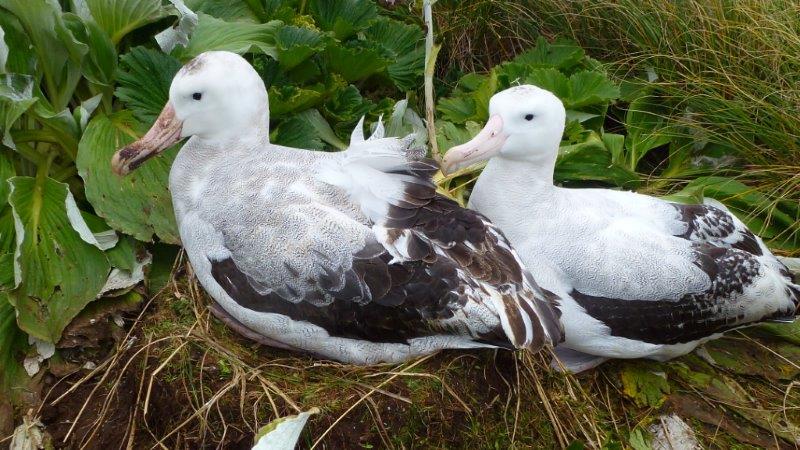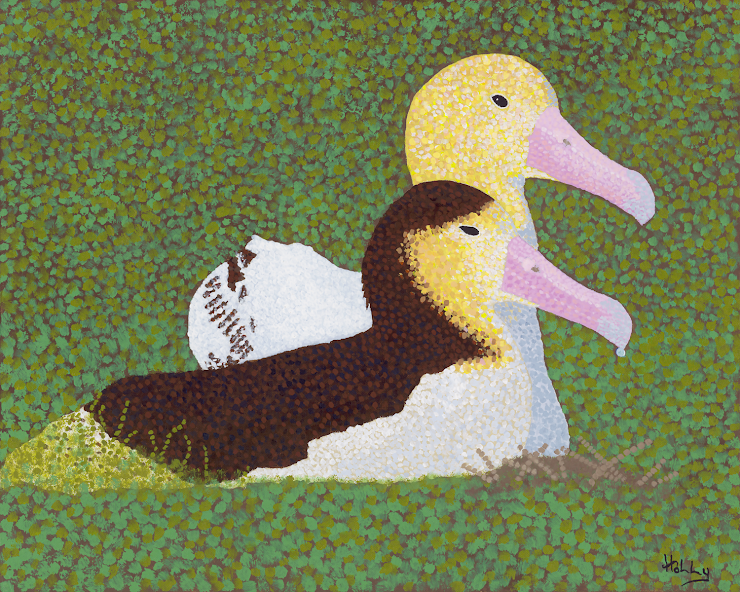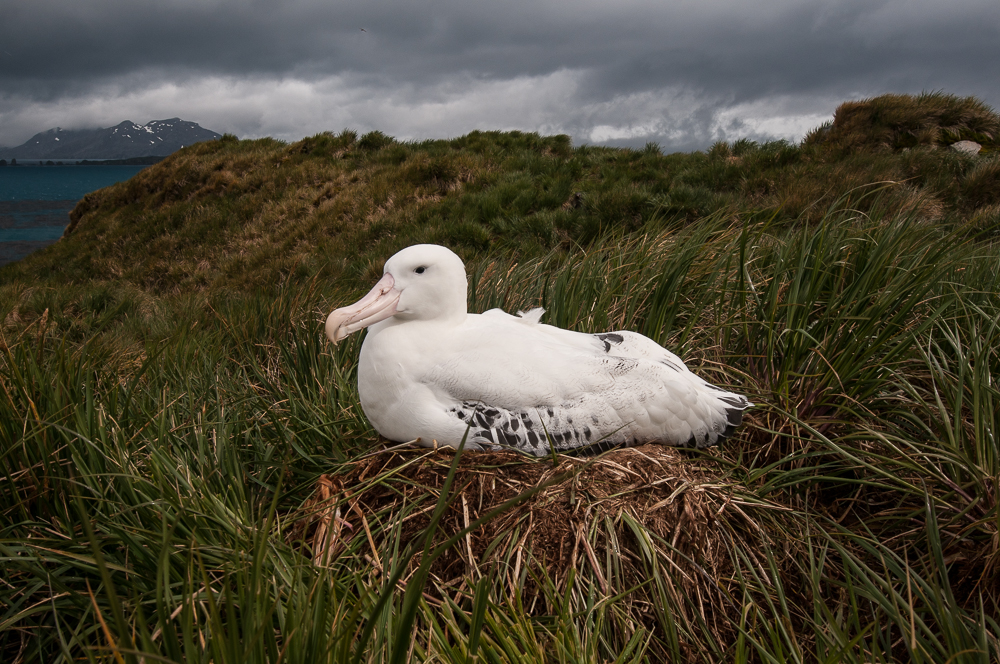
An Antipodean Albatross pair on Adams Island, photograph by Colin O’Donnell ONZM
Graeme Elliott ONZM (Department of Conservation, Nelson, New Zealand) and colleagues have produced a final report for the Conservation Services Programme of the New Zealand Department of Conservation that summarizes research conducted on the Gibson’s subspecies of the ACAP-listed and Endangered Antipodean Albatross Diomedea antipodensis gibsoni on Adams Island, Auckland Islands during the 2024/25 breeding season.
The report’s summary follows:
“Gibson’s wandering albatross (Diomedea antipodensis gibsoni) have been in decline since 2005. Research into the causes of and solutions to the falling numbers of Gibson’s albatross includes an annual visit to the main breeding grounds on Adams Island and this report describes the results of the 2025 breeding season. Breeding success in 2024 was 46%, the lowest for 8 years, with only 37 chicks produced from the study colony. The number of pairs nesting in three representative census blocks in 2025 was close to the average of the last ten years, with the poor breeding season in 2024 probably a “blip” rather than the start of a steep decline. Survival of both males and females has improved though confidence intervals around the most recent estimates are so large the level of improvement is not yet clear.
Satellite transmitters taped to the back feathers of 29 adult Gibson’s wandering albatross in January 2022 remained attached for an average of 179 days and those attached in January 2024 to 20 adults for 251 days, providing detailed information on patterns of use of the Tasman Sea. A combined total 10,204 days of tracking was recorded from even numbers of adult males and females, 19 of which were not-breeding and 30 of which were. One breeding female was almost certainly caught in June 2024 in the mid Tasman Sea by a longliner flagged to Chinese Taipei. Given the limited number of birds with transmitters and days tracked, this capture suggests an annual mortality rate of adults in fisheries interactions of 3.5% in the two years. Sixteen Gibson’s wandering albatross chicks about to fledge from Adams Island were fitted with satellite transmitters in late December 2024 and their movements will be followed throughout 2025.
In January 2024 and January 2025 aerial photographs were taken using drones of the entire breeding grounds of Gibson’s albatross on Adams Island. All 4,000ha of albatross nesting habitat was photographed across the two seasons, and 24% was photographed in both years. Orthomosaic images were constructed from the photos and the number of albatrosses on the ground in the orthomosaics were counted. Ground calibration checks undertaken at the same time as the photographs were used to provide correction factors of the proportion of birds on the ground which had eggs (has-egg rate; mean was 54% in 2024 and 67% in 2025). Another correction was made for the likely proportion of eggs not yet laid or nests that had failed at the time the photographs were taken. This lay-fail correction was derived from regular visits to the study area. The two corrections were applied to the number of birds counted from the drone imagery on Adams Island in 2024 and 2025. To estimate each year’s whole island number of breeding pairs, a growth-rate estimate from blocks counted both years was applied to blocks only counted in one year. The mean of the two year’s estimates was 4,497 breeding pairs. This is the first time since 1997 the number of breeding pairs nesting on Adams Island have been comprehensively assessed across the island. The proportion nesting in annual count blocks in 2024 (9.2%) and 2025 (9.7%) are similar to that recorded in 1997 (10.7%), indicating that the annual count blocks remain representative of whole-island trends in nest numbers. Compared to the ground counts undertaken in 1997, the drone-based estimates provided better coverage as drones could easily go everywhere but nesting birds couldn’t be distinguished from other birds on the ground from drone imagery. Therefore, the number of nesting birds is estimated not counted. In contrast, counts undertaken on foot can easily miss birds either obscured by vegetation or in places that are too difficult to walk, but the number of nesting birds is counted not estimated. It is not possible to objectively judge which method is better, but the drone estimates are easier.”
Reference:
Elliott, G., Walker, K., Rexer-Huber, K, Tinnemans, J., McDonald, A., Rawlence, T. & Parker, G. 2025. Gibson’s Wandering Albatross: Drone-based Population Estimate, Demography and at-sea Distribution. Report Prepared for New Zealand Department of Conservation. 33 pp.
John Cooper, Emeritus Information Officer, Agreement on the Conservation of Albatrosses and Petrels, 01 September 2025

 English
English  Français
Français  Español
Español 




 A breeding Wandering Albatross on Prion Island, photograph by Anton Wolfaardt
A breeding Wandering Albatross on Prion Island, photograph by Anton Wolfaardt